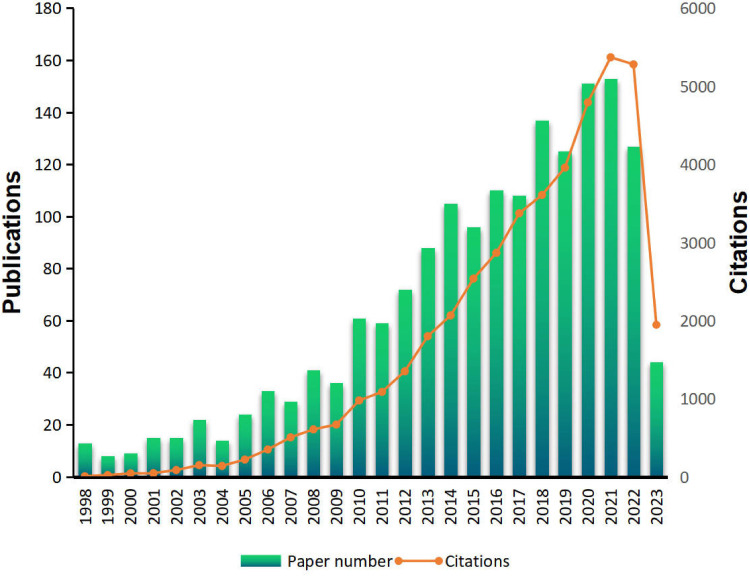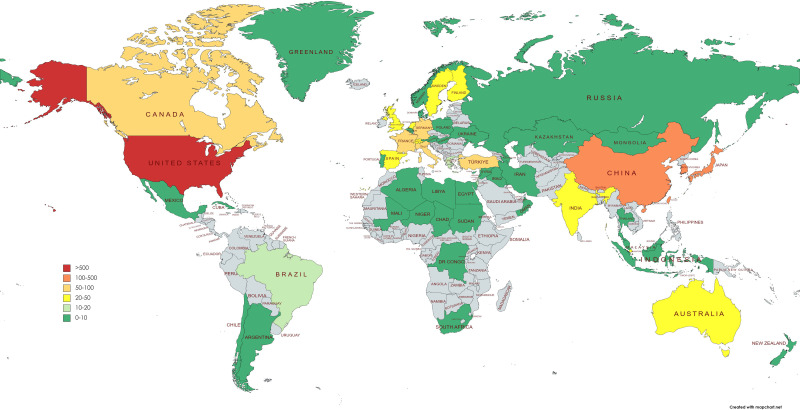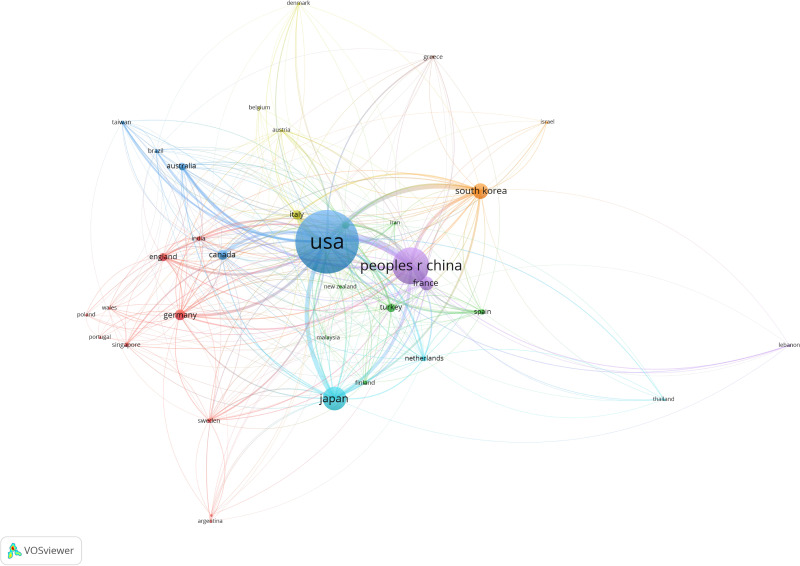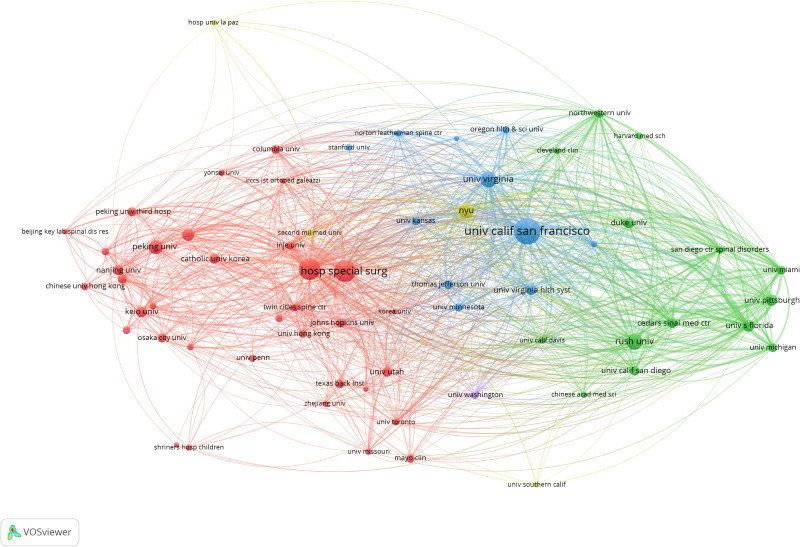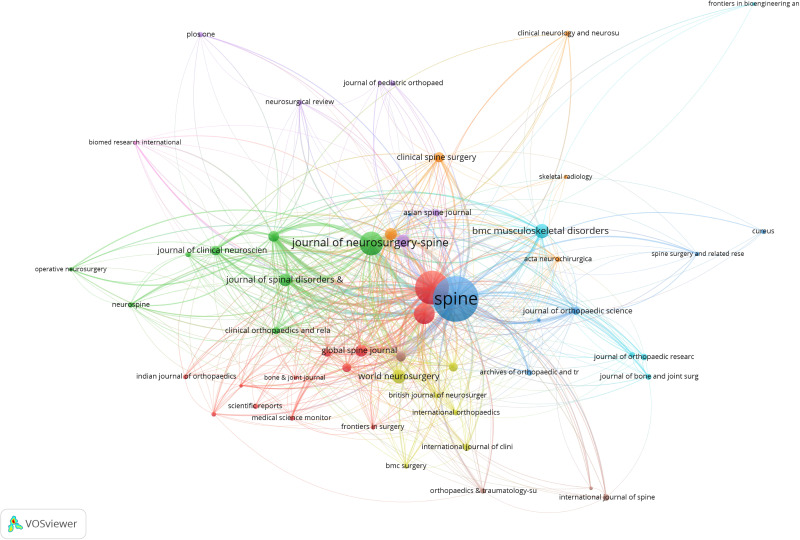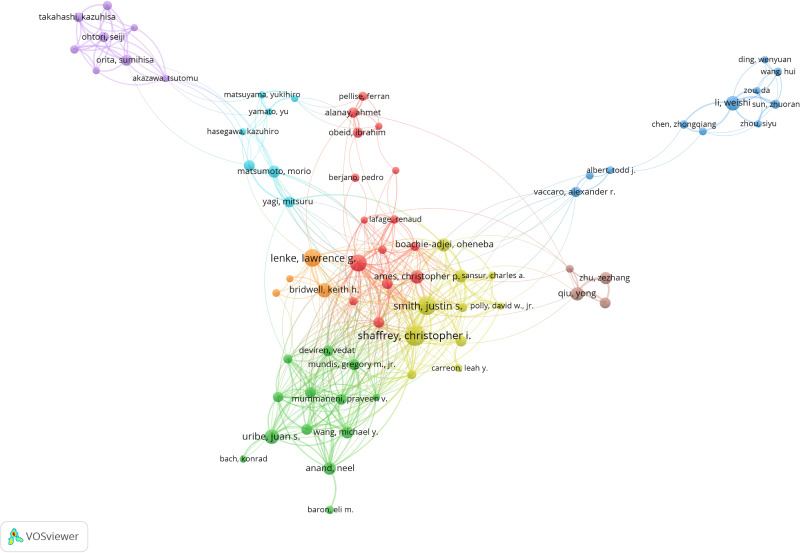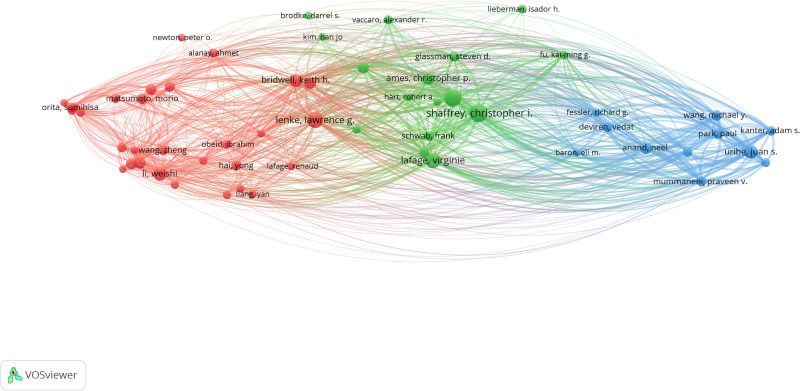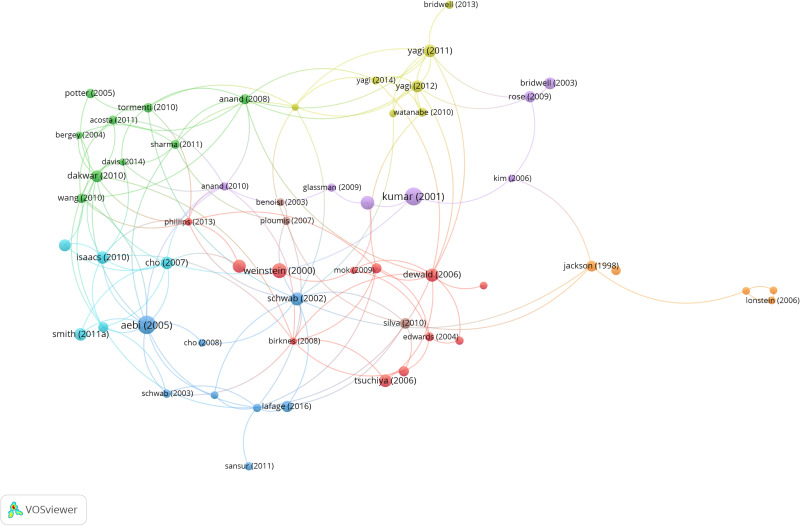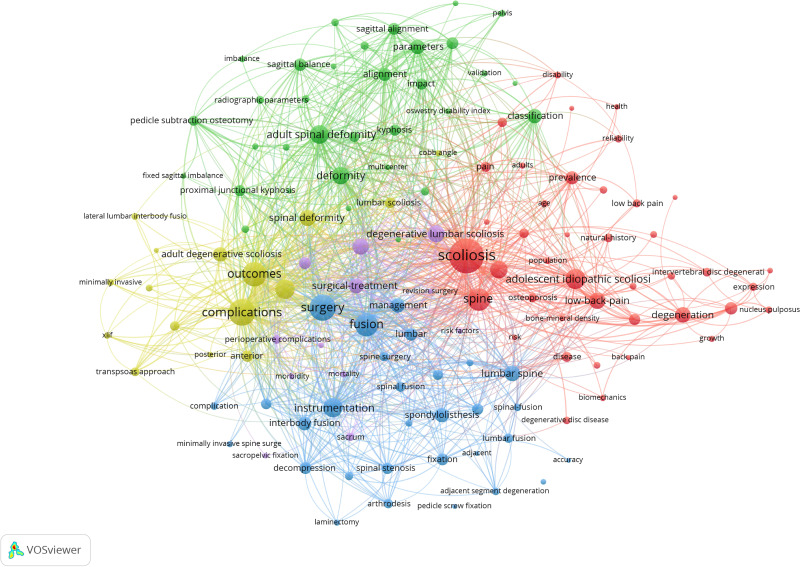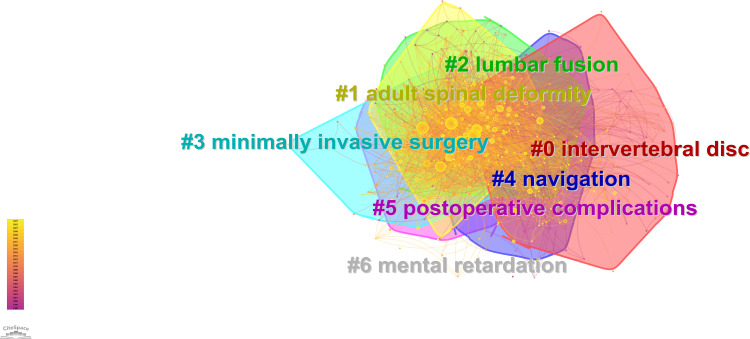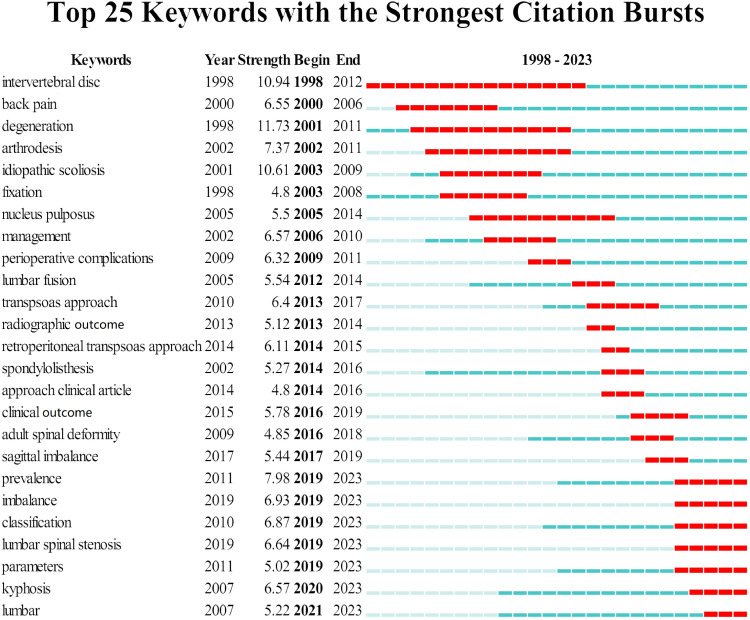Abstract
Purpose
Adult degenerative scoliosis (ADS) research lacks bibliometric analysis, despite numerous studies. This study aimed to systematically analyze the development, current status, hot topics, frontier areas, and trends in ADS research.
Patients and Methods
A systematic literature review was conducted in the Web of Science Core Collection database from January 1998 to June 2023. Information regarding the country, institution, author, journal, and keywords was collected for each article. Bibliometric analysis was performed using VOSviewer and Citespace software.
Results
The final analysis covered 1695 publications, demonstrating a steady increase in ADS research. The United States was the most prolific and influential country with 684 publications, followed by China and Japan. The University of California System was the most productive institution with 113 publications. Shaffrey, CI (47 publications) and Lenke, LG (41 publications) were top authors. The analysis revealed seven main research clusters: “intervertebral disc”, “adult spinal deformity”, “lumbar fusion”, “minimally invasive surgery”, “navigation”, “postoperative complications”, and “mental retardation”. Keywords with strong bursts of activity included degeneration, prevalence, imbalance, classification, lumbar spinal stenosis, and kyphosis.
Conclusion
In conclusion, in recent years, ADS research has undergone rapid development. This study analyzed its hot topics, advancements, and research directions, making it the latest bibliometric analysis in this field. The findings aim to provide a new perspective and guidance for clinical practitioners and researchers.
Keywords: adult degenerative scoliosis, adult spinal deformities, bibliometric analysis, CiteSpace, VOSviewer
Introduction
Adult spinal deformity is defined by the presence of specific standing radiographic criteria: Cobb angle ≥ 20°; sagittal vertical axis (SVA) ≥ 50 mm; pelvic tilt (PT) ≥ 25°; and thoracic kyphosis (TK) T1-T12 ≥ 60°, with pelvic incidence minus lumbar lordosis (PI-LL) greater than 10.1 As a significant component of Adult Spinal Deformity (ASD), Adult Degenerative Scoliosis (ADS) represents a condition in elderly individuals arising from degenerative changes without pre-existing spinal malformations. It develops through asymmetrical intervertebral disc space collapse and facet joint degeneration, followed by subsequent lateral and/or rotational slippage. This degenerative transformation primarily occurs in the lumbar spine, leading to the loss of lumbar lordosis and resulting in poor sagittal plane alignment.2,3 Approximately 9% of the global population aged 40 and above is affected by ADS, with the highest prevalence observed in individuals over 60 years old.4 As the global population ages, the incidence of ADS is expected to rise. By 2050, the proportion of individuals aged 60 or above is projected to double, highlighting the need for further research on ADS.5 The etiology of ADS is multifactorial, involving genetic susceptibility and intervertebral disc degeneration.6 Furthermore, due to the unclear pathological mechanisms, although most individuals experience degenerative changes in the normal aging process, mechanical, nutritional, and genetic factors can expedite the progression of degenerative changes, potentially leading to significant pathological alterations.7 The degenerative process initiates within the intervertebral disc, causing alterations at both microstructural and macrostructural levels in disc anatomy, along with changes in biochemical and biomechanical properties. These changes include reduced disc height, decreased water and proteoglycan content, and increased enzymatic degradation.6 The degenerative transformation ultimately results in pathological changes in the facet joints and the joints’ load-bearing structures, leading to bone remodeling and instability in these joints. This rebuilding cycle contributes to the gradual degeneration of spinal ligaments, paraspinal, and trunk muscle tissues, ultimately leading to spinal deformities.
In recent years, bibliometric studies have gained popularity. Bibliometrics is widely applied for quantitative evaluation and forecasting of future trends in published research. It employs statistical and mathematical methods to measure and assess various aspects of scholarly publications, such as publication volume, citation patterns, authorship, and the impact of research output.8 Bibliometric tools (CiteSpace and VOSviewer) can be used for research evaluation, tracking scientific trends, and identifying influential authors or institutions within specific disciplinary domains. By analyzing patterns and relationships within research data, bibliometrics can provide valuable insights into the growth, development, and impact of scholarly fields. Similar methods have been employed by researchers in related fields for systematic bibliometric analysis.9–13 While there is extensive research in the field of degenerative scoliosis, mainly comprising original studies and reviews, systematic bibliometric research is limited. The abundance of studies can make it difficult to ascertain and summarize the development, focus, and trends of research. Therefore, bibliometric analysis is necessary.
Adult degenerative scoliosis is a distinct classification of spinal curvature, with disease characteristics that differ from other types of curvature, making separate research necessary. This study systematically analyzes papers published in the field from January 1998 to June 2023, employing quantitative and qualitative analysis. It explores information such as citations, authors, journals, countries of publication, and keywords. The study visualizes the connections and co-occurrence relationships between authors and countries, as well as performs analysis of co-citations. The aim is to summarize and synthesize the development, focus, and trends of the field through comprehensive bibliometric analysis, addressing the lack of systematic studies in this domain.
Materials and Methods
Sources of Data
All data were retrieved from the Web of Science Core Collection database (WoS), which is widely used in bibliometric research. We conducted a search in WoS for literature on degenerative scoliosis published within the time period of January 1, 1998, to June 15, 2023. The search strategy was as follows: TS=(Scoliosis OR “lumbar Scoliosis”) AND TS=(Degenerat*). The search results were refined by (1) document types (article or review), (2) language (English), and (3) index (Science Citation Index Expanded, Current Chemical Reactions, Index Chemicus).
To avoid bias caused by daily updates of the database, the literature search was completed on a single day (June 15, 2023), and two independent observers (G.Z.M. and W.J.) manually screened the studies based on titles and abstracts. These records were exported in a plain text file format of “Full Records and Cited References”. Each literature record contains relevant information for analysis, including title, authors, keywords, abstracts, and references.
Data Analysis
We conducted a comprehensive analysis of the retrieved literature using Web of Science Results Analysis and Citation Report. This analysis covered various aspects, including annual publication count, citation count, rankings of authors, research institutions, and countries, as well as the distribution of related journals. The primary analysis tools used in this study are CiteSpace (available at http://cluster.cis.drexel.edu/wcchen/CiteSpace/) and VOSviewer (available at https://www.vosviewer.com/). The downloaded data was imported into VOSviewer version 1.6.19 and CiteSpace version 6.2.R3W for further analysis.
VOSviewer is a Java-based software tool commonly used for visualizing collaboration networks among authors, countries, and institutions, co-citation analysis, and keyword clustering to identify research hotspots. CiteSpace is a software program specifically designed for systematic measurement and analysis of bibliographic data. It can generate visual representations of information networks and trends, providing a panoramic view of the analysis results. CiteSpace is frequently used to evaluate research trends in various fields worldwide. In our study, we employed VOSviewer to analyze collaboration networks among authors, institutions, countries, and/or regions, as well as co-occurrence of references, generating co-authorship networks and keyword co-occurrence maps. Other analysis tasks were performed using CiteSpace. To establish the final dataset (1998–2023), we carefully selected and screened the records based on our predetermined criteria. The time slice used for analysis was 2 years, and the remaining parameters were set to their default values. Additionally, we utilized CiteSpace’s dual-map overlay feature for disciplinary and journal analyses. In the visualized network graph, the size of nodes indicates the degree of co-occurrence or citation frequency, while the connections between nodes reflect collaboration, co-occurrence, or co-citation relationships. The thickness of the links and the distance between nodes reveal the level of collaboration between countries, institutions, and authors. Lines reflect the connections between nodes.
In addition to the above analyses, we used Microsoft Excel 2016 to extract and analyze information such as authors, titles, journals, publication years, institutions, countries, total citation counts, and journal impact factors. We constructed various tables and charts to present the findings.
Results
Overall Characteristics of Publications
As shown in Figure 1, our analysis included a total of 1695 articles that met the inclusion criteria from 1998 to June 2023. This includes 1522 original articles and 173 reviews. The number of publications in this field has increased from 13 in 1998 to 127 in 2022, with a consistent upward trend in the overall publication count. The number of published articles was relatively low from 1998 to 2005, but it started to increase rapidly from 2009 onwards. 2021 was the year with the highest number of publications, with a total of 153 articles (Figure 1). The 1695 papers have been cited 43,841 times. The citation count has increased from 7 times in 1998 to 5371 times in 2021. This indicates that adult degenerative scoliosis has been receiving increasing attention, and more in-depth research is being conducted in this field.
Figure 1.
Number of reported studies and citations over time.
Country/Region Distribution
The collaboration among countries/regions, institutions, and authors was visualized using VOSviewer. The size of circles representing countries/regions, institutions, and authors represents the quantity of research, while the strength of connections represents the intensity of collaboration. The higher the connection strength and the greater the number of connections, the stronger, closer, and more active the collaborative relationship with other nodes.
As shown in Figure 2, research articles on adult degenerative scoliosis have been published by 62 countries and regions. Table 1 lists the top 10 countries in terms of publication quantity. The United States has the highest number of publications (40.35%, 684/1695), followed by China (19.71%, 334/1695), Japan (10.97%, 186/1695), South Korea (6.55%, 111/1695), and France (5.54%, 94/1695). To provide a visual representation of the collaboration among these countries and regions, a co-occurrence map (Figure 3) provides informative insights. The United States serves as a central hub of collaboration, with close ties to Japan, South Korea, and China. In the map, nodes represent countries/regions, and the size of the nodes corresponds to the quantity of publications. The lines connecting them represent collaborative relationships.
Figure 2.
Global distribution map of published articles.
Table 1.
Top 10 Countries with the Highest Publication Quantity
| Ranking | Country | Number | Percentage |
|---|---|---|---|
| 1 | USA | 684 | 40.35% |
| 2 | PEOPLES R CHINA | 334 | 19.71% |
| 3 | JAPAN | 186 | 10.97% |
| 4 | SOUTH KOREA | 111 | 6.55% |
| 5 | FRANCE | 94 | 5.55% |
| 6 | GERMANY | 67 | 3.95% |
| 7 | CANADA | 62 | 3.66% |
| 8 | ITALY | 58 | 3.42% |
| 9 | TURKEY | 51 | 3.01% |
| 10 | ENGLAND | 50 | 2.95% |
Figure 3.
Co-occurrence network map of countries/regions.
Institution Analysis
The publications included in the analysis are affiliated with a total of 1935 institutions. Table 2 ranks institutions based on the quantity of literature published in the field of adult degenerative scoliosis. The University of California System has the highest number of publications (6.67%, 113/1695), followed by the University of California San Francisco (4.54%, 77/1695), the University of Virginia (3.66%, 62/1695), Washington University WUSTL (3.48%, 59/1695), and Hospital for Special Surgery (3.30%, 56/1695). These institutions demonstrate significant influence in the field, indicating their contributions to research in adult degenerative scoliosis. Figure 4 illustrates the close collaboration among various institutions in the field.
Table 2.
Top 10 Institutions with the Highest Publication Quantity
| Ranking | Institution | Number | Percentage |
|---|---|---|---|
| 1 | UNIVERSITY OF CALIFORNIA SYSTEM | 113 | 6.67% |
| 2 | UNIVERSITY OF CALIFORNIA SAN FRANCISCO | 77 | 4.54% |
| 3 | UNIVERSITY OF VIRGINIA | 62 | 3.66% |
| 4 | WASHINGTON UNIVERSITY WUSTL | 59 | 3.48% |
| 5 | HOSP SPECIAL SURG | 56 | 3.30% |
| 6 | UDICE FRENCH RESEARCH UNIVERSITIES | 56 | 3.30% |
| 7 | NEW YORK UNIVERSITY | 42 | 2.48% |
| 8 | PEKING UNIVERSITY | 41 | 2.42% |
| 9 | RUSH UNIVERSITY | 40 | 2.36% |
| 10 | ASSISTANCE PUBLIQUE HOPITAUX PARIS APHP | 39 | 2.30% |
Figure 4.
Co-occurrence network map of institutions.
Journal Analysis
The included studies were distributed across 351 journals. Table 3 presents the journal ranking based on the number of documents. Out of 1695 articles on adult degenerative scoliosis, the majority were published in SPINE (281 articles; 16.58%), followed by EUROPEAN SPINE JOURNAL (171 articles; 10.09%), JOURNAL OF NEUROSURGERY SPINE (93 articles; 5.49%), SPINE JOURNAL (74 articles; 4.37%), and BMC MUSCULOSKELETAL DISORDERS (41 articles; 2.42%) (Figure 5). These journals are more likely to accept articles related to degenerative spinal curvature and demonstrate higher acceptance rates. Furthermore, articles published in these journals are likely to receive more attention and higher citation rates. As the dual-map (Figure 6) overlay of the journals shows, studies from neurology, sports, and ophthalmology had mostly cited studies from health, nursing, and medicine and psychology, education, and the social sciences.
Table 3.
Top 10 Journals with the Highest Publication Quantity
| Ranking | Journal | Number | Percentage |
|---|---|---|---|
| 1 | SPINE | 281 | 16.58% |
| 2 | EUROPEAN SPINE JOURNAL | 171 | 10.09% |
| 3 | JOURNAL OF NEUROSURGERY SPINE | 93 | 5.49% |
| 4 | SPINE JOURNAL | 74 | 4.37% |
| 5 | BMC MUSCULOSKELETAL DISORDERS | 41 | 2.42% |
| 6 | WORLD NEUROSURGERY | 39 | 2.30% |
| 7 | JOURNAL OF SPINAL DISORDERS TECHNIQUES | 34 | 2.01% |
| 8 | SPINE DEFORMITY | 33 | 1.95% |
| 9 | GLOBAL SPINE JOURNAL | 30 | 1.77% |
| 10 | NEUROSURGERY | 30 | 1.77% |
Figure 5.
Cooperation network of cited journals.
Figure 6.
Dual map overlay of journals related to degenerative scoliosis. (Left) Citing journals. (Right) Cited journals. The color of the links distinguishes the discipline of the source.
Author Analysis
A total of 7083 authors contributed to the 1695 articles. Table 4 presents the top ten most prolific authors. The top five authors are Shaffrey, CI (47 articles; 2.77%), Lenke, LG (41 articles; 2.42%), Smith, JS (36 articles; 2.12%), Bridwell, KH (33 articles; 1.95%), and Lafage, V (32 articles; 1.89%). The most cited author is Smith, Justin S (2326 citations), followed by Sun, Zhuoran (1957 citations), Li, Weishi (1818 citations), and Bridwell, Keith H. (1750 citations). Figure 7 depicts the collaboration network among the authors. Figure 8 illustrates several influential authors who have made significant contributions to the field. Co-citation links are established when two items from the same reference are cited together.
Table 4.
Top 10 Authors with the Highest Publication Quantity
| Ranking | Author | Number | Percentage | Affiliation |
|---|---|---|---|---|
| 1 | Shaffrey, CI | 47 | 2.77% | Durham University, USA |
| 2 | Lenke, LG | 41 | 2.42% | Columbia Orthoped Surg, USA |
| 3 | Smith, JS | 36 | 2.12% | University of Virginia, USA |
| 4 | Bridwell, KH | 33 | 1.95% | Washington University, USA |
| 5 | Lafage, V | 32 | 1.89% | Hospital for Special Surgery, USA |
| 6 | Li, WS | 25 | 1.48% | Peking University, PEOPLES R CHINA |
| 7 | Uribe, JS | 24 | 1.42% | Joseph’s Hospital and Medical Center, USA |
| 8 | Qiu, Y | 22 | 1.30% | Wusheng Cty Ctr Dis Control & Prevent, PEOPLES R CHINA |
| 9 | Watanabe, K | 22 | 1.30% | Keio University, JAPAN |
| 10 | Ames, CP | 21 | 1.24% | University of California San Francisco, USA |
Figure 7.
The network map of productive authors.
Figure 8.
Co-occurrence network map of authors.
Funding Analysis
The field of adult degenerative scoliosis research has received the highest amount of funding from the National Natural Science Foundation of China (NSFC), with 85 grants awarded. The United States Department of Health and Human Services has received the second highest number of grants, with a total of 48.
Reference Analysis
Table 5 presents the most cited literature in the field of adult degenerative scoliosis. Among them, 5 articles are from the United States, and one article each is from the United Kingdom, Canada, Switzerland, India, and Belgium. Figure 9 represents the co-citation network of the referenced literature, depicting the connections between the cited articles. The most cited literature is Roberts et al,14 followed by Alini et al,15 Aebi et al,16 Kumar et al17 and Pandolfo et al18
Table 5.
Top 10 Citations in the Field of Adult Degenerative Scoliosis
| Ranking | Title | Authors | Country | Journal | Year | Citations |
|---|---|---|---|---|---|---|
| 1 | Histology and pathology of the human intervertebral disc | Roberts, S14 | ENGLAND | JOURNAL OF BONE AND JOINT SURGERY-AMERICAN VOLUME | 200614 | 545 |
| 2 | Are animal models useful for studying human disc disorders/degeneration? | Alini, M15 | CANADA | EUROPEAN SPINE JOURNAL | 200815 | 519 |
| 3 | The adult scoliosis | Aebi, M16 | SWITZERLAND | EUROPEAN SPINE JOURNAL | 200516 | 490 |
| 4 | Correlation between sagittal plane changes and adjacent segment degeneration following lumbar spine fusion | Kumar, MN17 | INDIA | EUROPEAN SPINE JOURNAL | 200117 | 449 |
| 5 | Friedreich ataxia: The clinical picture | Pandolfo, M18 | BELGIUM | JOURNAL OF NEUROLOGY | 200918 | 354 |
| 6 | Trends in Lumbar Fusion Procedure Rates and Associated Hospital Costs for Degenerative Spinal Diseases in the United States, 2004 to 2015 | Martin, BI19 | USA | SPINE | 201919 | 337 |
| 7 | Postoperative spinal wound infection: A review of 2391 consecutive index procedures | Weinstein, MA20 | USA | JOURNAL OF SPINAL DISORDERS | 200020 | 336 |
| 8 | Risk factors for adjacent-segment failure following lumbar fixation with rigid instrumentation for degenerative instability | Etebar, S21 | USA | JOURNAL OF NEUROSURGERY | 199921 | 304 |
| 9 | Adult scoliosis - A quantitative radiographic and clinical analysis | Schwab, FJ22 | USA | SPINE | 200222 | 281 |
| 10 | Instrumentation-related complications of multilevel fusions for adult spinal deformity patients over age 65 - Surgical considerations and treatment option in patients with poor bone quality | DeWald, CJ23 | USA | SPINE | 200623 | 273 |
Figure 9.
Cooperation network of cited references.
Keyword and Research Hotspot Analysis
Using the co-occurrence network analysis tool in VOSviewer software, we conducted an analysis of keywords in research articles on adult degenerative scoliosis. In this analysis, a keyword had to appear at least 30 times in the articles to be considered. Keywords accurately represent the research topics. Summarizing high-frequency and highly bursted keywords in the papers helps describe research hotspots and trends. The size of nodes in the keyword co-occurrence mapping represents the weight of the keywords. The shorter the distance between nodes, the tighter the connection (Figure 10).
Figure 10.
Cooperation network of keywords.
Keyword clustering groups words and phrases with distinct domain characteristics into clusters. It utilizes an algorithm that extracts domain-specific and domain-general words from the original text features, controlling the influence of word frequency. A total of 5518 keywords were analyzed. Figure 11 displays seven clusters generated in this study: “intervertebral disc” #0, “adult spinal deformity” #1, “lumbar fusion” #2, “minimally invasive surgery” #3, “navigation” #4, “postoperative complications” #5, and “mental retardation” #6. The numbering is based on cluster size, and the clusters are systematically divided into several groups. The keywords within each cluster can be added.
Figure 11.
The cluster view map. The map is divided into several small grids, and the locations in each grid are grouped into a cluster. The smaller the number, the more keywords are included in the clusters.
To further understand the dynamic changes in research topics and identify research frontiers or emerging trends, we evaluated the evolution of the most frequently used keywords over different periods. Figure 12 displays the top 25 keywords with the strongest citation burst values. Red represents the periods of the strongest bursts, deep blue represents periods of appearance, and light blue indicates little or no appearance. The burst keywords with the longest duration, such as “intervertebral disc”, “degeneration”, “nucleus pulposus”, and “arthrodesis”, continue to demonstrate trends. Other keywords showing emerging trends include “prevalence”, “imbalance”, “classification”, “lumbar spinal stenosis”, “parameters”, “kyphosis”, and “lumbar”.
Figure 12.
Top 25 keywords with the strongest citation burst values.
Discussion
This study conducted a bibliometric analysis using the WoS database and VOSviewer/CiteSpace software to analyze 1695 published articles on adult degenerative scoliosis (ADS) from January 1, 1998, to June 15, 2023. The literature on adult degenerative scoliosis showed the most significant increase in 2009. The development path from 1998 to the present can be divided into two stages: a slow-developing early stage from 1998 to 2009 and a rapid-developing era from 2009 to the present. Additionally, as of June 2023, the year with the highest number of annual publications in the field of adult degenerative scoliosis was 2021. However, this does not imply that the number of publications in 2021 has reached the peak in this field. Many scholars have devoted themselves to research in this specialized field, resulting in numerous significant scientific discoveries and increasingly influential publications. Although the research is extensive, there is a lack of analysis on research focus and trends. In this study, we analyzed, discussed, and explained the research focus and trends in adult degenerative scoliosis. We hope that this study will help researchers gain a better understanding of the current research status and identify future research directions.
Analysis of the distribution of countries, institutions, and authors can contribute to strengthening collaboration and global communication in research topics. In terms of the number of published literature, the United States and China are the most influential countries in the field of adult degenerative scoliosis. Due to its large population, China has an advantage in recruiting adult degenerative scoliosis patients for clinical research. Driven by economic, technological, and knowledge advancements, China has continuously made innovative advancements in the diagnosis and treatment of adult degenerative scoliosis. Funding plays a crucial role in supporting research. The National Natural Science Foundation of China (NSFC) has provided the largest amount of funding in this research, with 85 grants awarded. Additionally, a considerable number of Chinese spine surgeons have become more proficient in writing papers. As an economic, scientific, and technological powerhouse, the United States plays a key role in leading scientific developments in various fields, including its significant contributions to adult degenerative scoliosis. Furthermore, the examination of the distribution of countries, institutions, and authors in the literature also indicates that Japan is an important contributor to research in this field.
Shaffrey, CI and Lenke, LG have published the most papers on this topic, ranking 15th and 8th in terms of citations, respectively. Both researchers are from the United States, indicating potential collaborations and a larger research network. In bibliometrics, the number of co-authors of research papers serves as a primary indicator of the research landscape. There are certain connections among countries, institutions, and authors, but the visualization maps also show weak links, indicating a lack of coordination among countries, organizations, and authors. Therefore, there is a need to enhance global academic collaboration across nations/regions and institutions.
Journal analysis can indeed help researchers choose the appropriate journals for paper submissions. The top five journals with the most published articles account for 38.95% of the total publication output. Spine is the most prolific journal in the field of adult degenerative scoliosis, with 14,620 citations, making it the most cited journal. Based on the number of publications and citations, Spine and the European Spine Journal are the dominant journals in this discipline. These publications are likely to be more receptive to research in the field of adult degenerative scoliosis. Additionally, articles published in these journals are more likely to receive attention and citations. We recommend readers to explore relevant articles in these journals and submit high-quality manuscripts to them on related topics.
Keywords not only serve as indicators of research focus and outcomes but also reflect prevailing research trends. Investigating the popularity of studies in this domain forms a critical basis for analyzing the evolving focal points in adult degenerative scoliosis (ADS) research. Through the analysis of keyword clustering centers, the pivotal role of intervertebral discs in the etiology and progression of ADS becomes apparent. Epidemiological considerations and classification provide valuable perspectives and have garnered increased attention in recent years. Surgical interventions have consistently been a central focus in this field, with fusion techniques representing a core theme. From traditional posterior approaches to emerging lateral procedures, surgical paradigms continue to advance. Additionally, minimally invasive and navigation technologies have seen extensive application in the surgical management of ADS. The evaluation of orthopedic treatment outcomes and postoperative complications remains a focal area of inquiry among researchers.
Research Focus
The Initiating Factor of ADS---Intervertebral Disc
When it comes to degenerative spinal diseases, the intervertebral disc is an unavoidable topic. Adult degenerative scoliosis is a spinal deformity that primarily affects adults, especially women. It is characterized by asymmetrical intervertebral discs and degeneration of facet joints, leading to spinal imbalance. This can result in severe pain and neurological deficits, significantly reducing the quality of life.24 The core feature of its pathogenesis is a self-reinforcing cycle driven by asymmetrical degeneration of intervertebral discs and facet joints at different levels.25 Anatomically, the intervertebral disc consists of three components: the nucleus pulposus, annulus fibrosus, and cartilaginous endplates (which attach the disc to the corresponding vertebra).26 Nucleus pulposus cells play a crucial role in maintaining the integrity of the intervertebral disc by producing extracellular matrix (ECM) components such as aggregating proteoglycans, type II collagen, and type X collagen.27 During the process of intervertebral disc degeneration, the functionality of nucleus pulposus cells is impaired, leading to changes in cell proliferation, cell death, abnormal production/degradation of ECM, and cytokine secretion.26 Inflammatory mechanisms drive intervertebral disc degeneration, disc neovascularization, autophagy, and remodeling of the ECM, which are key events in the process of intervertebral disc degeneration in adult degenerative scoliosis.24
Surgical Treatment of ADS
Surgery is an important approach in treating adult degenerative scoliosis (ADS). Patients with ADS present a range of neurological symptoms, including back pain, neurogenic claudication, radiculopathy, and global imbalance. When conservative treatments fail to provide relief, surgery becomes necessary. The primary goal of surgery is to achieve adequate decompression, stabilization, and restoration of coronal and sagittal alignment of the spine.28 Interbody fusion surgery has gained popularity in ADS due to its ability to restore disc and foraminal height, providing indirect decompression, good fusion, correction of spinal kyphosis, and deformity correction.29 Traditional posterior approaches such as posterior lumbar interbody fusion (PLIF) and transforaminal lumbar interbody fusion (TLIF) have proven successful in ADS. However, pure posterior fusion requires additional osteotomy, resulting in significant blood loss, extensive damage to the paraspinal muscles, and a higher risk of complications. New techniques performed through lateral approaches, such as lateral lumbar interbody fusion (LLIF), extreme lateral interbody fusion (XLIF), and oblique lumbar interbody fusion (OLIF), have gained popularity. These techniques indirectly decompress by increasing foraminal height. The lateral approach is favored because it minimizes muscle trauma, provides a large fusion surface area, accommodates larger cages, and requires fewer fusion segment.29 Both posterior (PLIF/TLIF) and lateral (LLIF/XLIF/OLIF) lumbar interbody fusion surgeries have demonstrated similar functional and radiographic outcomes in patients with mild to moderate ADS.30 However, before selecting the lateral approach, considerations must be given to potential risks such as injury to the lumbar plexus, bowel injury, vascular injury, changes in patient positioning for prone surgery, and difficulties accessing the L5-S1 disc space.29,31
Minimally invasive techniques have been continually advancing and are also applied in surgical treatments for adult spinal deformities. Qiu et al reported satisfactory outcomes in 831 adult scoliosis patients who underwent minimally invasive treatment. Postoperative coronal Cobb angle, Oswestry Disability Index (ODI), and Visual Analogue Scale (VAS) scores showed significant improvement.32 Compared to open surgery, percutaneous screw and rod insertion have advantages in correcting adult spinal deformities, with minimal soft tissue damage, less blood loss, and faster recovery of daily activities.33 Despite these advantages, percutaneous spinal deformity correction has specific limitations, as it cannot correct significant coronal and/or sagittal plane deformities without osteotomies. In a study by Anand et al34, successful correction of adult spinal deformities in 71 patients was reported to have good to excellent functional outcomes, a low pseudarthrosis rate, and satisfactory clinical and radiographic improvements. In conclusion, when choosing the surgical approach, indications and complications should be carefully considered, and the safety and efficacy of the procedure should be thoroughly evaluated.
The Use of Navigation Technology in the Surgery of ADS
In spinal surgery, accurate screw placement is crucial to avoid vascular or neurological complications and to achieve optimal fusion and deformity correction. Currently, there are three main techniques for pedicle screw insertion in the thoracolumbar spine: manual, fluoroscopy-guided, and stereotactic navigation. In recent years, with the advent of more advanced computer processors and imaging technologies, the successful integration of real-time information with three-dimensional anatomical structures has become possible, known as computer-assisted navigation (CAN), which is increasingly popular in spinal surgery.35,36 Computer-assisted navigation systems are based on two-dimensional or three-dimensional images and utilize high-speed computer processing of large amounts of data to provide real-time surgical navigation and simulation capabilities.37 It provides surgeons with accurate anatomical localization and operative guidance, improving the precision and safety of the surgery, and offering a more minimally invasive approach with better outcomes for patients. CAN has been shown to improve workflow in the operating room and enhance the safety and accuracy of minimally invasive instrumentation compared to manual or fluoroscopy-guided screw placement.38–40 Compared to fluoroscopy-guided techniques, spinal navigation technology can achieve an accuracy rate of over 97% in the placement of screws in minimally invasive surgeries, reaching 100% accuracy even with final three-dimensional scans. This further reduces the occurrence of neurological complications, allows the use of larger diameter screws, increases the biomechanical strength of the entire construct, and reduces the risk of implant failure or pseudarthrosis formation. Additionally, spinal navigation technology reduces surgical time, particularly in multilevel surgeries, and decreases radiation exposure for both the surgical team and the patient.41 Besides improving the accuracy of screw and interbody implant placement, navigation technology can also assist in planning three-column osteotomies in the surgical correction of spinal deformities, providing advantages in terms of accuracy, safety, and radiation exposure.42,43 Potential drawbacks include a steep learning curve similar to that of minimally invasive surgery and high initial equipment costs,44 but the use of CAN can avoid revision surgeries, resulting in significant cost savings.45
Like other bibliometric analyses, this study also has certain limitations. The first limitation is temporal lag. Some recently published high-quality studies may not have been fully included as they have not received sufficient citations yet. Second, due to the selection of articles being limited to English language publications, we may have missed some non-English articles with high impact. Third, although the software was used for objective analysis, there are inherent subjective biases in the interpretation of these results. Fourth, only articles from the WoS Core Collection were included in the analysis, so our findings may not be comprehensive.
Despite these limitations, this study holds special significance for the field. It is the first bibliometric study in the area of adult spinal deformity, systematically analyzing its development, focus, and trends. Future researchers should pay more attention to the most popular and recent clusters and read the highly cited literature in the field.
Conclusion
Over the past 25 years (1998–2023), there has been a growing global interest in Adult Degenerative Scoliosis (ADS) and its associated research. We conducted a comprehensive analysis of ADS literature, examining publication details such as countries, institutions, authors, journals, and keywords. Our findings highlighted research hotspots, including etiological studies, epidemiology, classification, and treatment approaches for ADS. Surgical intervention for ADS, management of postoperative complications, and assessments of life quality have consistently been focal points. Trends in the field, particularly related to ADS classification and deformity assessment, provide a scientific foundation for more precise and standardized treatment. Furthermore, research on the etiology of ADS, focusing on intervertebral discs, holds significant potential for guiding future prevention and treatment strategies. Our study aims to succinctly summarize the development, key areas, and trends in the ADS field, offering valuable insights for researchers and clinicians engaged in ADS research.
Funding Statement
This work was supported by the National Natural Science Foundation of China(81472140), the Natural Science Foundation of Tianjin City (S20ZDD484), National Key R&D Program of China (2022YFF1202500, 2022YFF1202503), Health and Technology Project of Tianjin Municipal Commission, Grant No. zc20219 and Tianjin Key Medical Discipline(Specialty) Construction Project (TJYXZDXK-026A).
Abbreviations
ADS, Adult degenerative scoliosis; WOS, Web of Science; NSFC, National Natural Science Foundation of China; ECM, extracellular matrix; PLIF, posterior lumbar interbody fusion; TLIF, transforaminal lumbar interbody fusion; LLIF, lateral lumbar interbody fusion; XLIF, extreme lateral interbody fusion; OLIF, oblique lumbar interbody fusion; ODI, Oswestry Disability Index; VAS, Visual Analogue Scale; CAN, computer-assisted navigation.
Data Sharing Statement
The Web of Science Core Collection (WoSCC) allows for direct retrieval of the raw data.
Ethics Approval
This article does not contain any studies with human or animal subjects performed by any of the authors.
Author Contributions
All authors made a significant contribution to the work reported, whether that is in the conception, study design, execution, acquisition of data, analysis and interpretation, or in all these areas; took part in drafting, revising or critically reviewing the article; gave final approval of the version to be published; have agreed on the journal to which the article has been submitted; and agree to be accountable for all aspects of the work.
Disclosure
The authors report no conflicts of interest in this work.
References
- 1.Schwab F, Ungar B, Blondel B, et al. Scoliosis Research Society-Schwab adult spinal deformity classification: a validation study. Spine. 2012;37(12):1077–1082. doi: 10.1097/BRS.0b013e31823e15e2 [DOI] [PubMed] [Google Scholar]
- 2.Graham RB, Sugrue PA, Koski TR. Adult degenerative scoliosis. Clin Spine Surg. 2016;29(3):95–107. doi: 10.1097/BSD.0000000000000367 [DOI] [PubMed] [Google Scholar]
- 3.Wong E, Altaf F, Oh LJ, Gray RJ. Adult Degenerative Lumbar Scoliosis. Orthopedics. 2017;40(6):e930–e939. doi: 10.3928/01477447-20170606-02 [DOI] [PubMed] [Google Scholar]
- 4.McAviney J, Roberts C, Sullivan B, Alevras AJ, Graham PL, Brown BT. The prevalence of adult de novo scoliosis: a systematic review and meta-analysis. Eur Spine J. 2020;29(12):2960–2969. doi: 10.1007/s00586-020-06453-0 [DOI] [PubMed] [Google Scholar]
- 5.Schwab F, Dubey A, Gamez L, et al. Adult scoliosis: prevalence, SF-36, and nutritional parameters in an elderly volunteer population. Spine. 2005;30(9):1082–1085. doi: 10.1097/01.brs.0000160842.43482.cd [DOI] [PubMed] [Google Scholar]
- 6.Diebo BG, Shah NV, Boachie-Adjei O, et al. Adult spinal deformity. Lancet. 2019;394(10193):160–172. doi: 10.1016/S0140-6736(19)31125-0 [DOI] [PubMed] [Google Scholar]
- 7.Benoist M. Natural history of the aging spine. Eur Spine J. 2003;12(Suppl 2):S86–S89. doi: 10.1007/s00586-003-0593-0 [DOI] [PMC free article] [PubMed] [Google Scholar]
- 8.Lin GX, Nan JN, Chen KT, et al. Bibliometric analysis and visualization of research trends on oblique lumbar interbody fusion surgery. Int Orthop. 2022;46(7):1597–1608. doi: 10.1007/s00264-022-05316-1 [DOI] [PubMed] [Google Scholar]
- 9.Liu Z, Cheng Y, Hai Y, Chen Y, Liu T. Developments in congenital scoliosis and related research from 1992 to 2021: a thirty-year bibliometric analysis. World Neurosurg. 2022;164:e24–e44. doi: 10.1016/j.wneu.2022.02.117 [DOI] [PubMed] [Google Scholar]
- 10.Liu Z, Gao K, Hai Y, Developments LT. Focuses, and trends in early-onset scoliosis from 2005 to 2020: a systematic bibliometric analysis. World Neurosurg. 2022;158:e697–e710. doi: 10.1016/j.wneu.2021.11.044 [DOI] [PubMed] [Google Scholar]
- 11.Liu PC, Lu Y, Lin HH, et al. Classification and citation analysis of the 100 top-cited articles on adult spinal deformity since 2011: a bibliometric analysis. J Chin Med Assoc. 2022;85(3):401–408. doi: 10.1097/JCMA.0000000000000642 [DOI] [PubMed] [Google Scholar]
- 12.Zhao T, Li Y, Dai Z, et al. Bibliometric analysis of the scientific literature on adolescent idiopathic scoliosis. World Neurosurg. 2021;151:e265–e277. doi: 10.1016/j.wneu.2021.04.020 [DOI] [PubMed] [Google Scholar]
- 13.Tao L, Zhou S, Tao Z, et al. The publication trends and hot spots of scoliosis research from 2009 to 2018: a 10-year bibliometric analysis. Ann Translat Med. 2020;8(6):365. doi: 10.21037/atm.2020.02.67 [DOI] [PMC free article] [PubMed] [Google Scholar]
- 14.Roberts S, Evans H, Trivedi J, Menage J. Histology and pathology of the human intervertebral disc. J Bone Joint Surg Am Vol. 2006;88(Suppl 2):10–14. doi: 10.2106/JBJS.F.00019 [DOI] [PubMed] [Google Scholar]
- 15.Alini M, Eisenstein SM, Ito K, et al. Are animal models useful for studying human disc disorders/degeneration? Eur Spine J. 2008;17(1):2–19. doi: 10.1007/s00586-007-0414-y [DOI] [PMC free article] [PubMed] [Google Scholar]
- 16.Aebi M. The adult scoliosis. Eur Spine J. 2005;14(10):925–948. doi: 10.1007/s00586-005-1053-9 [DOI] [PubMed] [Google Scholar]
- 17.Kumar MN, Baklanov A, Chopin D. Correlation between sagittal plane changes and adjacent segment degeneration following lumbar spine fusion. Eur Spine J. 2001;10(4):314–319. doi: 10.1007/s005860000239 [DOI] [PMC free article] [PubMed] [Google Scholar]
- 18.Pandolfo M. Friedreich ataxia: the clinical picture. J Neurol. 2009;256(Suppl 1):3–8. doi: 10.1007/s00415-009-1002-3 [DOI] [PubMed] [Google Scholar]
- 19.Martin BI, Mirza SK, Spina N, Spiker WR, Lawrence B and Brodke DS. Trends in Lumbar Fusion Procedure Rates and Associated Hospital Costs for Degenerative Spinal Diseases in the United States, 2004 to 2015. Spine. 2019. ;44(5):369–376. 10.1097/BRS.0000000000002822 [DOI] [PubMed] [Google Scholar]
- 20.Weinstein MA, McCabe JP and Cammisa FP. Postoperative Spinal Wound Infection: A Review of 2,391 Consecutive Index Procedures. Journal of Spinal Disorders. 2000;13(5):422–426. 10.1097/00002517-200010000-00009 [DOI] [PubMed] [Google Scholar]
- 21.Etebar S and Cahill DW. Risk factors for adjacent-segment failure following lumbar fixation with rigid instrumentation for degenerative instability. Journal of Neurosurgery: Spine 1999;90(2(Suppl)):163–169. 10.3171/spi.1999.90.2.0163 [DOI] [PubMed] [Google Scholar]
- 22.Schwab FJ, Smith VA, Biserni M, Gamez L, Farcy JC and Pagala M. Adult Scoliosis. Spine. 2002;27(4):387–392. 10.1097/00007632-200202150-00012 [DOI] [PubMed] [Google Scholar]
- 23.DeWald CJ and Stanley T. Instrumentation-Related Complications of Multilevel Fusions for Adult Spinal Deformity Patients Over Age 65. Spine. 2006;31(Suppl):S144–S151. 10.1097/01.brs.0000236893.65878.39 [DOI] [PubMed] [Google Scholar]
- 24.Petrosyan E, Fares J, Lesniak MS, Koski TR, El Tecle NE. Biological principles of adult degenerative scoliosis. Trends Mol Med. 2023;29(9):740–752. doi: 10.1016/j.molmed.2023.05.012 [DOI] [PubMed] [Google Scholar]
- 25.Kotwal S, Pumberger M, Hughes A, Girardi F. Degenerative scoliosis: a review. HSS J. 2011;7(3):257–264. doi: 10.1007/s11420-011-9204-5 [DOI] [PMC free article] [PubMed] [Google Scholar]
- 26.Shi X, Li P, Wu X, Wang Z, Zhao G, Shu J. RNA-seq comprehensive analysis reveals the long noncoding RNA expression profile and coexpressed mRNA in adult degenerative scoliosis. Front Genet. 2022;13:902943. doi: 10.3389/fgene.2022.902943 [DOI] [PMC free article] [PubMed] [Google Scholar]
- 27.Roughley PJ. Biology of intervertebral disc aging and degeneration: involvement of the extracellular matrix. Spine. 2004;29(23):2691–2699. doi: 10.1097/01.brs.0000146101.53784.b1 [DOI] [PubMed] [Google Scholar]
- 28.Cho KJ, Kim YT, Shin SH, Suk SI. Surgical treatment of adult degenerative scoliosis. Asian Spine J. 2014;8(3):371–381. doi: 10.4184/asj.2014.8.3.371 [DOI] [PMC free article] [PubMed] [Google Scholar]
- 29.Mobbs RJ, Phan K, Malham G, Seex K, Rao PJ. Lumbar interbody fusion: techniques, indications and comparison of interbody fusion options including PLIF, TLIF, MI-TLIF, OLIF/ATP, LLIF and ALIF. J Spine Surg. 2015;1(1):2–18. doi: 10.3978/j.issn.2414-469X.2015.10.05 [DOI] [PMC free article] [PubMed] [Google Scholar]
- 30.Mittal S, Sudhakar PV, Ahuja K, et al. Deformity correction with interbody fusion using lateral versus posterior approach in adult degenerative scoliosis: a systematic review and observational meta-analysis. Asian Spine J. 2023;17(2):431–451. doi: 10.31616/asj.2022.0040 [DOI] [PMC free article] [PubMed] [Google Scholar]
- 31.Arnold PM, Anderson KK, McGuire RA. The lateral transpsoas approach to the lumbar and thoracic spine: a review. Surg Neurol Int. 2012;3(Suppl 3):S198–S215. doi: 10.4103/2152-7806.98583 [DOI] [PMC free article] [PubMed] [Google Scholar]
- 32.Liu G, Liu S, Zuo YZ, et al. Recent advances in technique and clinical outcomes of minimally invasive spine surgery in adult scoliosis. Chinese Med J. 2017;130(21):2608–2615. doi: 10.4103/0366-6999.212688 [DOI] [PMC free article] [PubMed] [Google Scholar]
- 33.Anand N, Baron EM, Kahwaty S. Evidence basis/outcomes in minimally invasive spinal scoliosis surgery. Neurosurg Clin North Am. 2014;25(2):361–375. doi: 10.1016/j.nec.2013.12.014 [DOI] [PubMed] [Google Scholar]
- 34.Anand N, Baron EM, Khandehroo B, Kahwaty S. Long-term 2- to 5-year clinical and functional outcomes of minimally invasive surgery for adult scoliosis. Spine. 2013;38(18):1566–1575. doi: 10.1097/BRS.0b013e31829cb67a [DOI] [PubMed] [Google Scholar]
- 35.Kochanski RB, Lombardi JM, Laratta JL, Lehman RA, O’Toole JE. Image-guided navigation and robotics in spine surgery. Neurosurgery. 2019;84(6):1179–1189. doi: 10.1093/neuros/nyy630 [DOI] [PubMed] [Google Scholar]
- 36.Kelly PD, Zuckerman SL, Yamada Y, et al. Image guidance in spine tumor surgery. Neurosurg Rev. 2020;43(3):1007–1017. doi: 10.1007/s10143-019-01123-2 [DOI] [PMC free article] [PubMed] [Google Scholar]
- 37.Yamout T, Orosz LD, Good CR, Jazini E, Allen B, Gum JL. Technological advances in spine surgery: navigation, robotics, and augmented reality. Orthop Clin North Am. 2023;54(2):237–246. doi: 10.1016/j.ocl.2022.11.008 [DOI] [PubMed] [Google Scholar]
- 38.Rawicki N, Dowdell JE, Sandhu HS. Current state of navigation in spine surgery. Ann Translat Med. 2021;9(1):85. doi: 10.21037/atm-20-1335 [DOI] [PMC free article] [PubMed] [Google Scholar]
- 39.Hussain I, Navarro-Ramirez R, Lang G, Härtl R. 3D navigation-guided resection of giant ventral cervical intradural schwannoma with 360-degree stabilization. Clin Spine Surg. 2018;31(5):E257–E265. doi: 10.1097/BSD.0000000000000511 [DOI] [PubMed] [Google Scholar]
- 40.Navarro-Ramirez R, Lang G, Lian X, et al. Total navigation in spine surgery; a concise guide to eliminate fluoroscopy using a portable intraoperative computed tomography 3-dimensional navigation system. World Neurosurg. 2017;100:325–335. doi: 10.1016/j.wneu.2017.01.025 [DOI] [PubMed] [Google Scholar]
- 41.Kassis SZ, Abukwedar LK, Msaddi AK, Majer CN, Othman W. Combining pedicle screw stimulation with spinal navigation, a protocol to maximize the safety of neural elements and minimize radiation exposure in thoracolumbar spine instrumentation. Eur Spine J. 2016;25(6):1724–1728. doi: 10.1007/s00586-015-3973-3 [DOI] [PubMed] [Google Scholar]
- 42.Kosterhon M, Gutenberg A, Kantelhardt SR, Archavlis E, Giese A. Navigation and image injection for control of bone removal and osteotomy planes in spine surgery. Operat Neurosurg. 2017;13(2):297–304. doi: 10.1093/ons/opw017 [DOI] [PubMed] [Google Scholar]
- 43.Shin JH, Yanamadala V, Cha TD. Computer-assisted navigation for real time planning of pedicle subtraction osteotomy in cervico-thoracic deformity correction. Operat Neurosurg. 2019;16(4):445–450. doi: 10.1093/ons/opy162 [DOI] [PubMed] [Google Scholar]
- 44.Malham GM, Wells-Quinn T. What should my hospital buy next?-Guidelines for the acquisition and application of imaging, navigation, and robotics for spine surgery. J Spine Surg. 2019;5(1):155–165. doi: 10.21037/jss.2019.02.04 [DOI] [PMC free article] [PubMed] [Google Scholar]
- 45.Al-Khouja L, Shweikeh F, Pashman R, Johnson JP, Kim TT, Drazin D. Economics of image guidance and navigation in spine surgery. Surg Neurol Int. 2015;6(Suppl 10):S323–S326. doi: 10.4103/2152-7806.159381 [DOI] [PMC free article] [PubMed] [Google Scholar]



